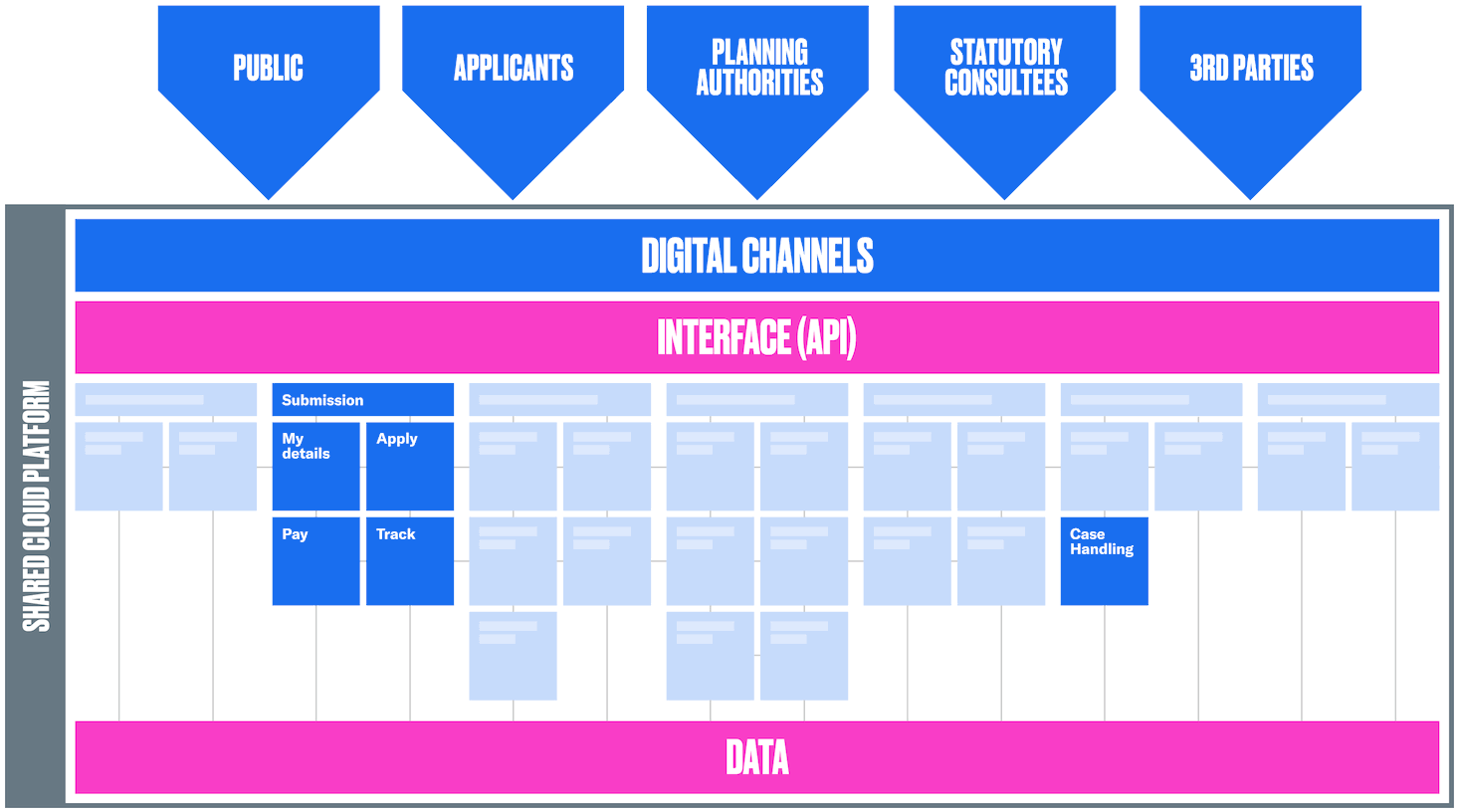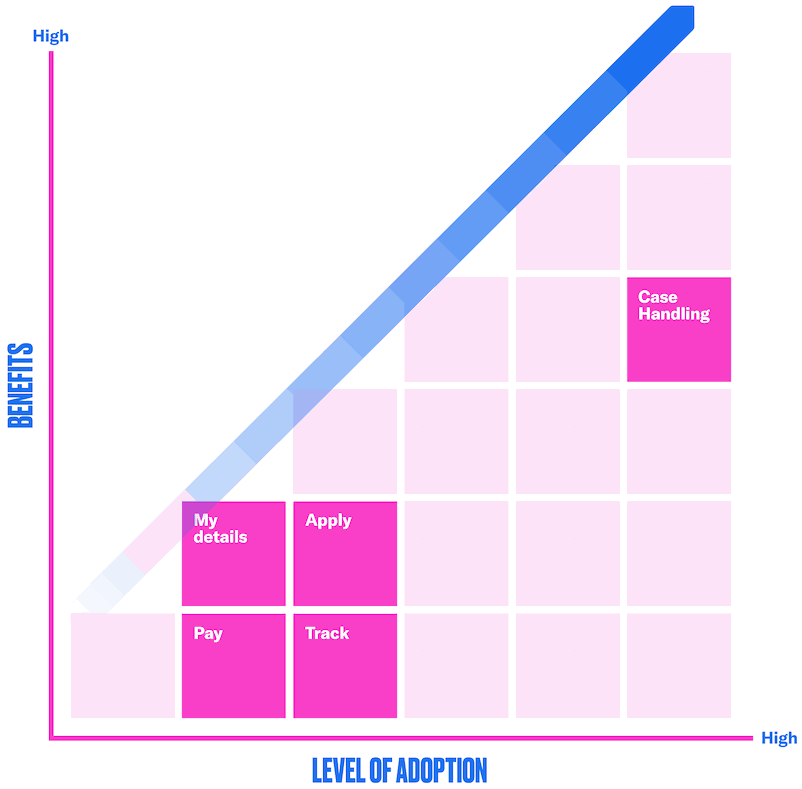Transforming Places Together: digital strategy for planning
This strategy defines a long-term strategic direction for how Scotland’s planning system will digitally transform, embracing the opportunities new digital technologies and data present. It sets out what we intend to deliver, why this is needed and the benefits this transformation will bring.
The digital transformation programme
Technology approach
It is not our intention to set out a detailed technical architecture for a digitally transformed planning system within this strategy. However, we have developed a high-level technical approach aimed at meeting the aspirations (vision, missions and principles) within the strategy.
As part of this we have looked in detail at the current service delivery patterns involved in both Development Planning and Development Management, analysing both the specific stages involved and the technologies currently used to support them.
We have also mapped the individual component parts of the planning system (capabilities). Doing this at an early stage has helped to validate the high-level approach and identify the technical deliverables that will form part of the programme.
The technology we implement for a future digital planning system needs to support, and interface with, a full range of capabilities, some of which are illustrated in this section. This integration will allow us to meet the ambitions for transformation and innovation that our strategy outlines. We recognise that this will often mean linking with existing technologies implemented by planning authorities.
“We have developed a high-level technical approach aimed at meeting the aspirations within the strategy.”
We want technology and data to:
- Bring together Development Planning and Development Management so that developments consented by planners are informed by data and policies set out in forward plans. This means that the effectiveness of policies can be monitored in near-real-time
- Reduce the potential for vendor lock-in so that Scotland’s planning technology and data is not bound into any particular provider’s proprietary system
- Enable greater use of innovative technologies by allowing the integration of 3rd party solutions within our Interoperability and Standards Framework
- Enable flexible adoption for planning authorities making it easier to incrementally implement aspects of a new shared platform and realising greater benefits over time
- Deliver a consistent experience for users so that it supports simpler interactions with the planning system
- Provide all users of the planning system with the right data at the right time
- Make planning more accessible for citizens
- Continue to drive Scotland’s Digital Economy
- Work with the existing local authority technology landscape
- Stimulate the private sector to use and build innovative solutions with the data available
In order to do that we need a technical architecture that:
- Is cloud-based. Adopting a cloud-first architecture and a shared cloud platform will allow a digitally transformed planning system to benefit from the advanced security, high availability, scalability, and integration technologies that cloud vendors are constantly investing in
- Is modular. Implementing a loosely coupled architecture for planning will allow parts of the technology used in planning to be replaced with more advanced and innovative solutions as they become available. It will also facilitate opportunities for new suppliers to provide their solutions more easily, helping to stimulate the digital economy
- Is interoperable. To ensure that a modular approach works well, the interoperability of planning technology will be a key focus for us
- Is open. Adopting open standards and opening up planning data for re-use will allow planning to contribute to Scotland’s Digital Economy
- Is able to reuse and contribute to the digital ecosystem and promotes the “reuse over buy over build” principle
- Is easily able to interface with existing planning authorities technology systems using APIs within the cloud platform. This will allow planning authorities to choose the extent to which they wish to adopt the shared technology we propose. With a transformation programme lasting several years, we acknowledge that not all planning authorities will be able (or want) to move quickly to a new technology platform and we have designed our approach to accommodate for this. We call this the ‘hybrid approach’
- Is based on standards. Adopting and continuing to promote standards for design, interoperability and data will be key to our technology approach
Technology approach

A shared cloud platform for planning
We propose to establish a shared cloud platform as the central component of a future planning system.
Moving to a cloud environment for planning will enable more rapid development of a future digital planning system. It will also simplify interactions with public agencies and 3rd parties who are part of the planning process such as Scottish Environmental Protection Agency and Scottish Water. We know from research that these interactions also have the potential to be transformed and to introduce much greater speed and efficiency.
We imagine an environment in which connections to existing systems continue to exist and this has formed a key consideration in our technology approach. We acknowledge that some capabilities required to deliver planning are shared amongst other services delivered by local authorities, and the proposed cloud platform will accommodate for these interactions with existing technologies and processes via APIs.
We will ensure that data is:
Actively managed and governed
Local data is valuable nationally, and national data is valuable locally. We will work with planning authorities and data partners to agree how data is managed and governed to ensure the value of the data can be realised at all levels and across all stakeholders.
Comprehensive
The Place Principle promotes a shared understanding of place and the need to take a more collaborative approach to a place’s services and assets to achieve better outcomes for people and communities. This requires that data from across themes be brought together to form a comprehensive picture of a place.
Fit for purpose
We will work with data partners to ensure that the data they supply is suited to planning use cases.
Accessible in one place
We will work with data partners to ensure that all the data planners need to plan is available or signposted in one place
Standardised
Working with planning authorities and data partners, we will work to agree common standards for data so it can be joined up at local, regional, and national levels to facilitate measurement of outcomes against policy, as well as facilitate cross-border planning.
Up to date and high quality
Data quality and timeliness is key to engendering trust in the data. We will work with planning authorities and data partners to ensure that this is a priority for them and that feedback from data consumers about the data is transparent so it can be acted on.
Re-usable
High quality data produced by planners has great value to other sectors providing it is accessible for re-use beyond planning.
A flexible and beneficial approach to adoption
We want to ensure that planning authorities can benefit from our approach to technology whether they implement only some of it, or go further and choose to move entirely to a shared cloud platform.
However, we believe the greatest benefits will be realised by those who take on more of the shared technology we develop collaboratively.
For example, moving to cloud based case handling will mean that planning authorities will benefit from full end-to-end processing of smart applications, reducing manual handling and allowing planning authorities time to focus on the real job of planning – making effective decisions that improve our places.

A standards framework
Having a loosely coupled architecture makes it even more important that the right standards are put in place to ensure new planning technologies can work together. It also makes it vitally important that we focus on creating a consistent experience for users of the planning system.
We propose to adopt clear standards for user experience (design), interoperability and data across all the technology implemented in a transformed planning system.
Apply
- Capability
- Design standards
- APIs
- Data standards
A migration path
We will work with early adopter authorities to develop a holistic approach that considers whether a ‘big bang cutover’ or a ‘run in parallel’ migration approach is best. The migration strategy will:
- Allow authorities to migrate when conditions are right for them
- Support the business through the change
- Take skills and training into account
- Ensure historic data is not lost
- Consider data cleansing and remediation
- Ensure in-flight planning applications are not impacted
- Not disrupt Planning’s touchpoints with other business areas
- Support the incremental adoption of the new digital planning services
Contact
Email: digitalplanning@gov.scot
There is a problem
Thanks for your feedback